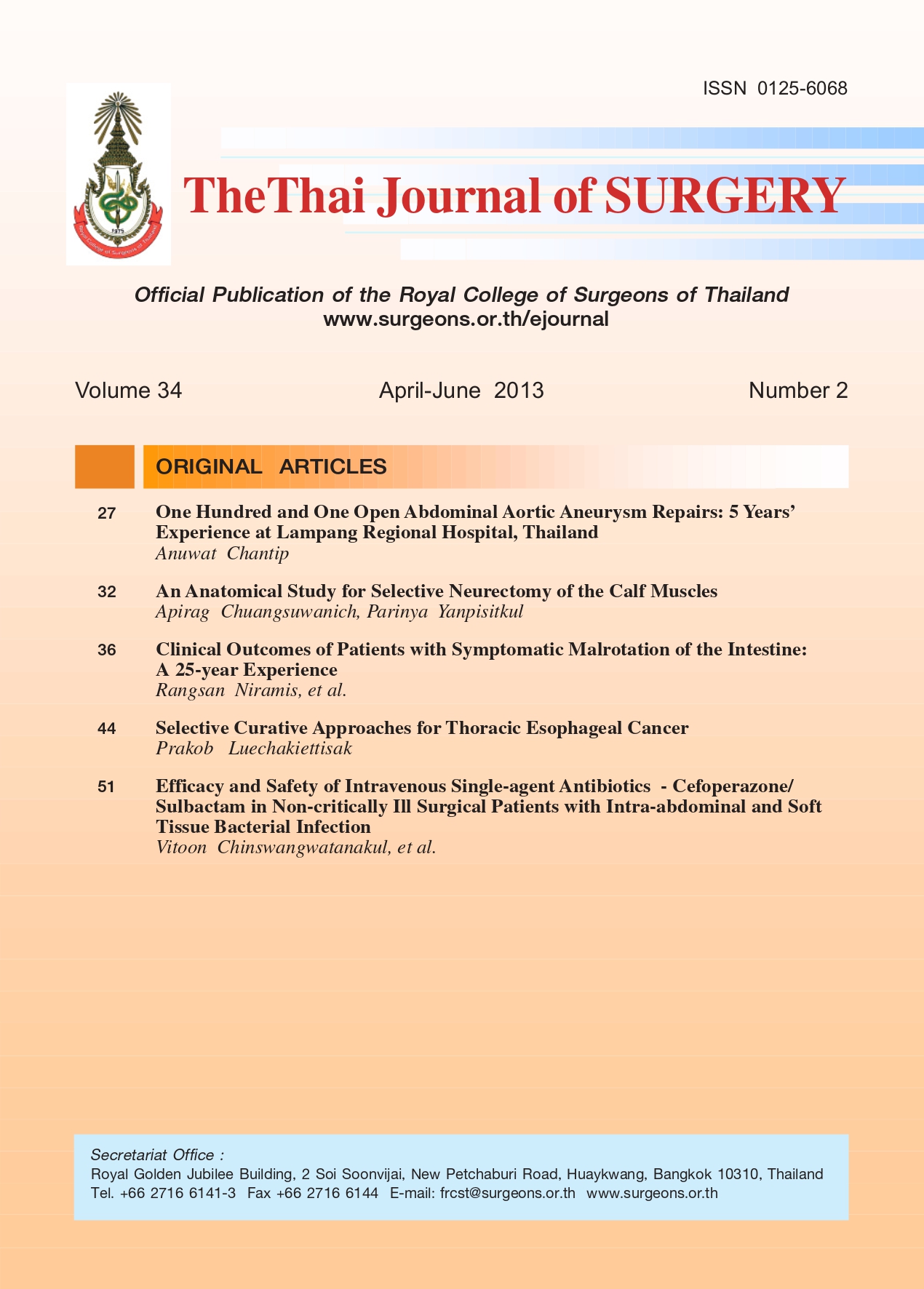An Anatomical Study for Selective Neurectomy of the Calf Muscles
Keywords:
Selective neurectomy, calf muscle reduction, anatomical studyAbstract
Background: Calf hypertrophy is an aesthetic concern for women. Many methods such as liposuction,botulinum toxin type A injection and muscle resection have been used to reduce the calf size with reasonable
results. A technique of selective neurectomy of the medial gastrocnemius and soleus muscles is used to improve
the result of calf muscle reduction. There are few reports of selective neurectomy for calf hypertrophy in
clinical cases and of anatomical study of nerves to gastrocnemius and soleus muscle.
Objective: To demonstrate the anatomical variation of nerves to gastrocnemius and soleusmuscles.
Methods: Thirty five cadaveric legs (22 males and 13 females) with an average age of 43.7 years were
dissected to determine the location of nerves to the gastrocnemius and soleus muscles. Number, direction and
location of these nerves were recorded.
Results: The nerve to the soleus muscle had 2 branches: medial and lateral. The nerve to medial
gastrocnemius had 1 branch in 31 (89%) and 2 branches in 4 (11%) of the legs examined. The nerve to the lateral
gastrocnemius had only 1 branch in all legs. Eighteen male legs (82%) had 1 branch of nerve to the medial
gastrocnemius and 4 male legs (18%) had 2 branches. All female legs had 1 branch of nerve to the medial
gastrocnemius.
Conclusion: The nerves to medial and lateral soleus muscles have a constant number of branches, but the
nerve to the medial gastrocnemius has variable number of branches.
References
female leg. Aesthetic Plast Surg 2000;24:303-5.
2. Lee HJ, Lee DW, Park YH, Cha MK, Kim HS and Ha SJ.
Botulinum toxin A for aesthetic contouring of enlarged
medial gastrocnemius muscle. Dermatol Surg 2004;30:867-
71.
3. Kim IG, Hwang SH, Lew JM, Lee HY. Endoscope-assisted
calf reduction in Orientals. Plast Reconstr Surg 2000;106:713-
8.
4. Thorne CH, Beasley RW, Aston SJ, Bartlett SP, Gurtner GC,
Spear SL. Liposuction. In Grabb& Smith’s Plastic Surgery ed.
6th. 2007;533.
5. Tsai FC, Mardini S, Fong TH, Kang JH, Chou CM. Selective
neurectomy of Gastrocnemius and soleus muscles for calf
hypertrophy: An anatomical study and 700 clinical cases.
Plast Reconstr Surg 2008;122:178-87.
6. Hwang K, Kim YJ, Chung IH, Won HS, Tanaka S, Lee SI.
Innervation of calf muscle inrelation to calf reduction. Ann
Plast Surg 2003;50:517-22.
7. Tsai FC, Hsieh MS, Chou CM. Comparison between
neurectomy and botulinum toxin A injection for denervated
skeletal muscle. J Neurotrauma 2010;27:1509-16.
8. Lee CJ, Park JH, Park SW. Compensatory hypertrophy of calf
muscle after selectiveneurectomy. Aesthetic Plast Surg
2006;30:108-12.
9. Lee JT, Wang CH, Cheng LF, Lin CM, Huang CC, Chien SH.
Subtotal resection of Gastrocnemius muscle for hypertropic
muscular calves in Asians. Plast Reconstr Surg 2006;118:1472-
83.
10. Young P, Yong J, Sa B, Hyung K, et al. Radiofrequency
volume reduction of gastrocnemius muscle hypertrophy
for cosmetic purposes. Aesthetic Plast Surg 2007;31:53-
61.
11. Chang HW. Excessive gastrocnemius fibrosis developed
after radiofrequency-induced cosmetic volume reduction.
Aesthetic Plast Surg 2011;35:1172-5.
12. Ing GK, Se HH, Jai ML, Hyeog YL. Endoscope-assisted calf
reduction. Orient Plast Reconstr Surg 2000;106:713-8.
Downloads
Published
How to Cite
Issue
Section
License
Articles must be contributed solely to The Thai Journal of Surgery and when published become the property of the Royal College of Surgeons of Thailand. The Royal College of Surgeons of Thailand reserves copyright on all published materials and such materials may not be reproduced in any form without the written permission.



